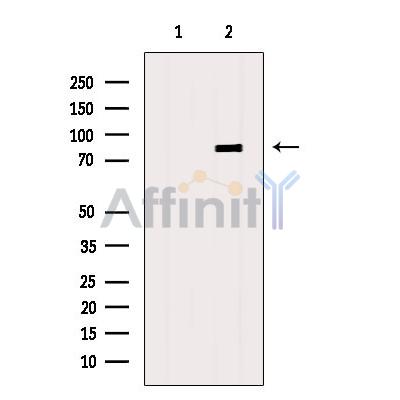DMP1 Antibody - #DF8825
| Product: | DMP1 Antibody |
| Catalog: | DF8825 |
| Description: | Rabbit polyclonal antibody to DMP1 |
| Application: | WB IHC |
| Cited expt.: | WB |
| Reactivity: | Human, Mouse, Monkey |
| Prediction: | Bovine, Sheep, Rabbit, Dog |
| Mol.Wt.: | 56 kDa, 80 kDa; 56kD(Calculated). |
| Uniprot: | Q13316 |
| RRID: | AB_2842022 |
Related Downloads
Protocols
Product Info
*The optimal dilutions should be determined by the end user. For optimal experimental results, antibody reuse is not recommended.
*Tips:
WB: For western blot detection of denatured protein samples. IHC: For immunohistochemical detection of paraffin sections (IHC-p) or frozen sections (IHC-f) of tissue samples. IF/ICC: For immunofluorescence detection of cell samples. ELISA(peptide): For ELISA detection of antigenic peptide.
Cite Format: Affinity Biosciences Cat# DF8825, RRID:AB_2842022.
Fold/Unfold
ARHP; ARHR; AV020965; Dentin matrix acidic phosphoprotein 1; Dentin matrix protein 1; DENTMAT; DMP 1; Dmp; MGC130441; PP; Serine rich acidic phosphoprotein;
Immunogens
A synthesized peptide derived from human DMP1, corresponding to a region within C-terminal amino acids.
- Q13316 DMP1_HUMAN:
- Protein BLAST With
- NCBI/
- ExPASy/
- Uniprot
MKISILLMFLWGLSCALPVTRYQNNESEDSEEWKGHLAQAPTPPLESSESSEGSKVSSEEQANEDPSDSTQSEEGLGSDDHQYIYRLAGGFSRSTGKGGDDKDDDEDDSGDDTFGDDDSGPGPKDRQEGGNSRLGSDEDSDDTIQASEESAPQGQDSAQDTTSESRELDNEDRVDSKPEGGDSTQESESEEHWVGGGSDGESSHGDGSELDDEGMQSDDPESIRSERGNSRMNSAGMKSKESGENSEQANTQDSGGSQLLEHPSRKIFRKSRISEEDDRSELDDNNTMEEVKSDSTENSNSRDTGLSQPRRDSKGDSQEDSKENLSQEESQNVDGPSSESSQEANLSSQENSSESQEEVVSESRGDNPDPTTSYVEDQEDSDSSEEDSSHTLSHSKSESREEQADSESSESLNFSEESPESPEDENSSSQEGLQSHSSSAESQSEESHSEEDDSDSQDSSRSKEDSNSTESKSSSEEDGQLKNIEIESRKLTVDAYHNKPIGDQDDNDCQDGY
Predictions
Score>80(red) has high confidence and is suggested to be used for WB detection. *The prediction model is mainly based on the alignment of immunogen sequences, the results are for reference only, not as the basis of quality assurance.
High(score>80) Medium(80>score>50) Low(score<50) No confidence
Research Backgrounds
May have a dual function during osteoblast differentiation. In the nucleus of undifferentiated osteoblasts, unphosphorylated form acts as a transcriptional component for activation of osteoblast-specific genes like osteocalcin. During the osteoblast to osteocyte transition phase it is phosphorylated and exported into the extracellular matrix, where it regulates nucleation of hydroxyapatite.
Phosphorylated in the cytosol and extracellular matrix and unphosphorylated in the nucleus. Phosphorylation is necessary for nucleocytoplasmic transport and may be catalyzed by a nuclear isoform of CK2 and can be augmented by calcium. Phosphorylated (in vitro) by FAM20C in the extracellular medium at sites within the S-x-E/pS motif.
Nucleus. Cytoplasm. Secreted>Extracellular space>Extracellular matrix.
Note: In proliferating preosteoblasts it is nuclear, during early maturation stage is cytoplasmic and in mature osteoblast localizes in the mineralized matrix. Export from the nucleus of differentiating osteoblast is triggered by the release of calcium from intracellular stores followed by a massive influx of this pool of calcium into the nucleus.
Expressed in tooth particularly in odontoblast, ameloblast and cementoblast.
References
Application: WB Species: Human Sample: hDPSCs
Application: IF/ICC Species: Human Sample: hDPSCs
Application: WB Species: Human Sample: hSCAPs
Application: IF/ICC Species: Human Sample: hSCAPs
Application: WB Species: human Sample: hDPSCs
Application: WB Species: Human Sample:
Restrictive clause
Affinity Biosciences tests all products strictly. Citations are provided as a resource for additional applications that have not been validated by Affinity Biosciences. Please choose the appropriate format for each application and consult Materials and Methods sections for additional details about the use of any product in these publications.
For Research Use Only.
Not for use in diagnostic or therapeutic procedures. Not for resale. Not for distribution without written consent. Affinity Biosciences will not be held responsible for patent infringement or other violations that may occur with the use of our products. Affinity Biosciences, Affinity Biosciences Logo and all other trademarks are the property of Affinity Biosciences LTD.








